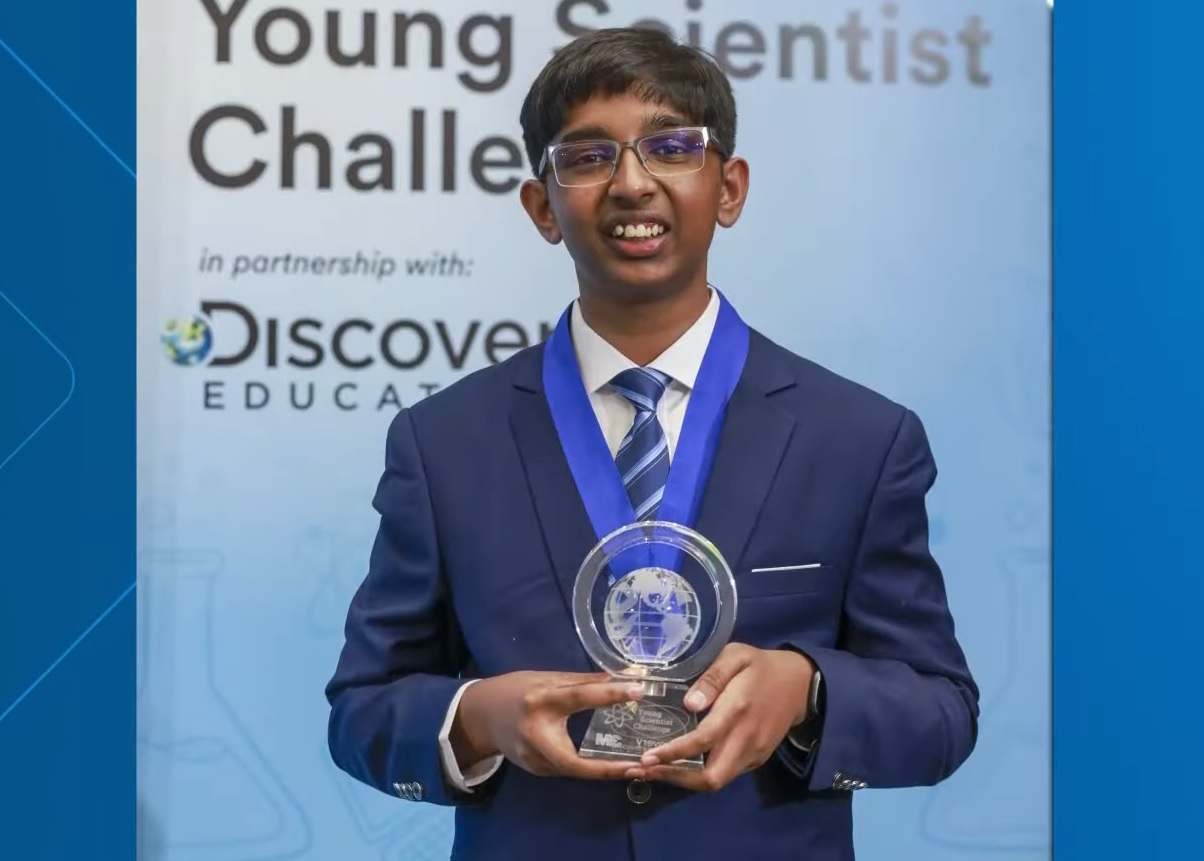14-Year-Old Wins ‘US TOP YOUNG SCIENTIST’ For Inventing Pesticide Detector For Fruits & Vegetable

Sometimes, it takes the fresh perspective of a young mind to shake up the way we see the world. Meet 14-year-old Sirish Subash from Snellville, Georgia—a kid with a vision and the determination to bring it to life. Crowned “America’s Top Young Scientist,” Sirish created a handheld device that can detect pesticide residues on fruits and vegetables. Think about that for a second—this is more than just an invention; it’s a wake-up call. His innovation challenges us to rethink what we put on our plates and raises an important question: how safe is the food we call ‘clean’?
How a 14-Year-Old Tackled Pesticide Risks in Produce
Sirish Subash, a 14-year-old from Snellville, Georgia, developed PestiSCAND, a handheld device to detect pesticide residues on produce, which won him the title of “America’s Top Young Scientist.” This innovation stems from a fundamental concern over the safety of washing fruits and vegetables, which often fails to remove all pesticide residues. Research indicates that a significant portion of produce carries pesticide residues, despite being washed, posing potential health risks like cancer and neurological disorders.
The motivation for Sirish’s invention came from a realization about the pervasive issue of pesticide contamination in our daily diet. Studies have shown that pesticide residues can remain on fruits and vegetables, and these chemicals, particularly older, off-patent ones like DDT, are persistent in the environment and have been linked to various health issues. The World Health Organization highlights that pesticides are crucial for increasing agricultural yield but also pose significant health risks if not regulated properly, necessitating strict residue monitoring and control measures.
Additionally, recent studies, including one from the MDPI journal, have underscored the prevalence of pesticide residues in produce from farmer markets, often exceeding the maximum residual limits set for safe consumption. This has been particularly noted with certain pesticides in commonly consumed fruits like apples and vegetables like cucumbers.
PestiSCAND: The Game-Changing Invention Backed by Science and Mentorship

Sirish Subash’s PestiSCAND device showcased its ability to detect pesticide residues on produce with notable precision. Through meticulous trials, PestiSCAND achieved an accuracy rate exceeding 85% in identifying pesticide residues, specifically on spinach and tomatoes. This was made possible by the device’s utilization of spectrophotometry and AI technology. Spectrophotometry measures how light at different wavelengths is reflected from the surface of fruits and vegetables, while the integrated AI model analyzes this data to determine the presence of pesticide residues.
The development and testing of PestiSCAND were part of Sirish’s participation in the 3M Young Scientist Challenge, where he was mentored by Aditya Banerji, a Senior Research Engineer at 3M’s Corporate Research Process Laboratory. This mentorship was crucial as it helped refine the device from a concept to a fully functioning prototype, ready for real-world application. The competition’s framework provided an interactive and supportive environment, encouraging the finalists to apply STEM principles creatively and effectively.
Implications and Future Potential
The implications of this innovation extend far beyond the kitchen. As Sirish plans to refine PestiSCAND and make it widely accessible, there is potential for this technology to become a staple in households globally, empowering consumers to make safer food choices directly. This device could also spur further innovations in food safety technology, encouraging other young scientists to develop new solutions to pressing global health issues.
The broader potential of PestiSCAND also includes its impact on environmental health, offering a tool that can help reduce the overall exposure to harmful chemicals, thereby supporting sustainable farming practices by highlighting the need for reduced pesticide use. Sirish’s vision for the future of his invention aligns with his academic and career aspirations, as he intends to continue developing projects that tackle real-world problems, with a particular focus on applications that could address climate change and environmental issues.
Recognition and Awards
 Image source: Pexels
Image source: Pexels
Sirish Subash, a ninth grader from Snellville, Georgia, has been awarded the prestigious title of “America’s Top Young Scientist” following his victory in the 2024 3M Young Scientist Challenge. His innovative creation, PestiSCAND, is an AI-powered handheld device designed to detect pesticide residues on produce. This significant achievement came with a $25,000 grand prize, which Sirish plans to use towards his higher education aspirations, notably at MIT where he hopes to continue developing impactful technological solutions.
The competition, a leading initiative for middle school students to address real-world problems through science and technology, showcases the critical importance of nurturing young innovators like Sirish. His project, recognized for its practical application and potential impact on food safety, involved a meticulous process of development under the mentorship of Aditya Banerji, a senior research engineer at 3M’s Corporate Research Process Laboratory.
Throughout his journey, Sirish has demonstrated not only his profound interest in science and technology but also a commitment to making a positive impact on public health and safety. His ongoing passion and determination serve as an inspiration to young scientists everywhere, highlighting the incredible potential of youth in STEM fields.
The Organic Advantage: Nutrition Meets Safety
Organic food offers a powerful combination of better nutrition and reduced exposure to harmful substances, making it a standout choice for health-conscious consumers. Backed by scientific research, organic produce not only minimizes pesticide use but also delivers higher levels of essential nutrients and antioxidants that support overall well-being. Organic foods contain:
- 19% more phenolic acids, which protect cells from damage.
- 69% more flavanones, linked to a lower risk of chronic diseases.
- 51% more anthocyanins, which support heart and brain health.
- 50% less Cadmium, a toxic heavy metal found in conventional produce.
By reducing harmful residues while boosting nutrient content, organic food provides a proactive approach to health. Combined with innovations like Sirish Subash’s PestiSCAND device for pesticide detection, we are entering an era where safe, nutrient-dense food is more accessible than ever.
How an Organic Diet Can Detox Your Body
In today’s world, pesticide exposure is a hidden reality of our daily diets. Conventional crops have been found to carry four times more pesticide residues than their organic counterparts, exposing us to harmful chemicals linked to a variety of health concerns. However, research shows that switching to an organic diet can significantly reduce pesticide levels in the body in just days.
- A 2015 study from RMIT University revealed that eating an organic diet for just one week reduced pesticide exposure in adults by up to 90%.
- A 2019 study in Environmental Research demonstrated similar findings, showing that an organic diet decreased exposure to pesticides such as neonicotinoids, OP pyrethroids, and chlorpyrifos, with the most dramatic reductions in malathion, clothianidin, and chlorpyrifos.
- Another experiment with four American families who typically ate conventional food showed that pesticide levels in their bodies dropped by an average of 60.5% within six days of switching to an organic diet.
By choosing organic foods, you not only minimize your intake of harmful pesticides but also give your body the chance to detox naturally. Eating organic is a simple yet powerful way to reduce your toxic burden and support overall health, helping you feel better from the inside out.
A New Era of Food Safety Begins
 Image source: Pexels
Image source: Pexels
Sirish Subash’s groundbreaking invention, PestiSCAND, not only earned him the title of “America’s Top Young Scientist” but also spotlighted the remarkable capabilities of young innovators in tackling real-world problems through science and technology. This AI-powered device, capable of detecting pesticide residues on produce, represents a significant step forward in ensuring food safety, potentially revolutionizing the way consumers interact with their food. As Sirish continues his educational journey, his story serves as an inspiration, demonstrating that passion combined with innovation can lead to meaningful changes in public health and environmental safety. The support and recognition provided by platforms like the 3M Young Scientist Challenge are crucial in fostering young talents who are poised to shape our future.
Featured Image Source: 11Alive News on YouTube
Source:
- Oates, L., Cohen, M., Braun, L., Schembri, A., & Taskova, R. (2014). Reduction in urinary organophosphate pesticide metabolites in adults after a week-long organic diet. Environmental Research, 132, 105–111. https://doi.org/10.1016/j.envres.2014.03.021
-
Oates, L., Cohen, M., Braun, L., Schembri, A., & Taskova, R. (2014). Reduction in urinary organophosphate pesticide metabolites in adults after a week-long organic diet. Environmental Research, 132, 105–111. https://doi.org/10.1016/j.envres.2014.03.021
Loading...






